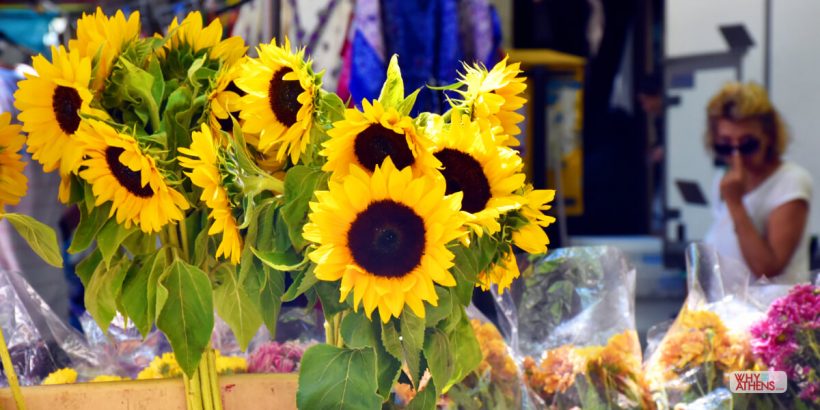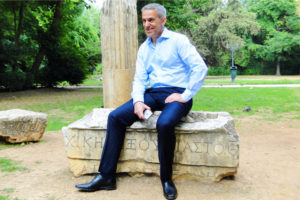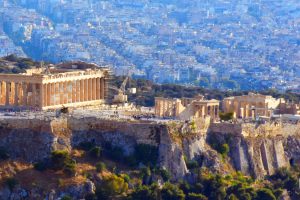Everywhere you look in Athens, there’s a story to be told. There are so many things that make this city unique; from its ancient and modern history to its architecture, food and way of life. It’s the small things too, from sunflowers basking in the summer sun to the gentle old Greek tortoises you’ll find crawling around ancient monuments. It’s also the grittiness of the city in the midst of change combined with a creative edge you’ll find flourishing in the emerging district of Metaxourgeio or down the small graffiti sprayed alleyways of Psirri. These are our weekly snapshots and stories to give you a glimpse of the old and new worlds of Athens Greece.
“A great city is not to be confounded with a populous one.” – Aristotle
Photographs and words by Why Athens
_________________________
The Sunflower in Greek Mythology
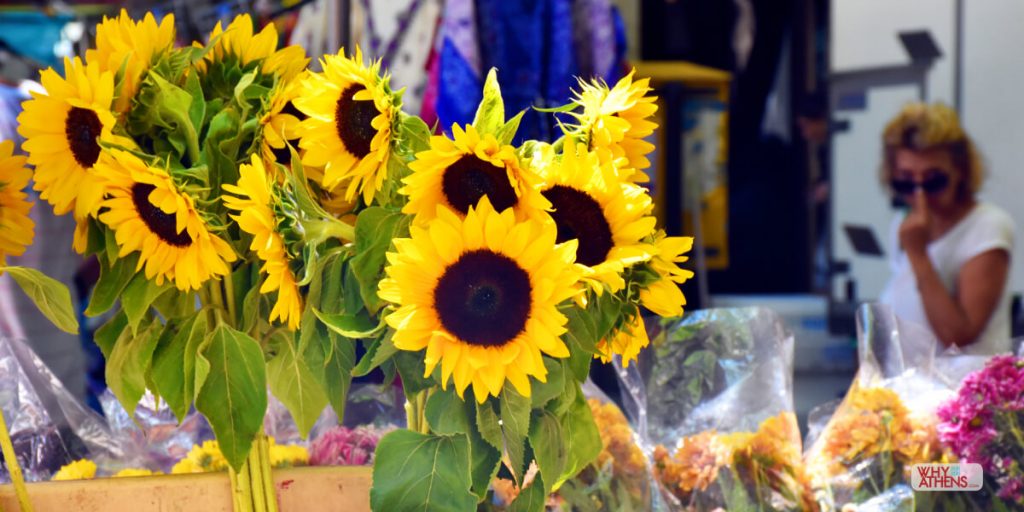
The Sunflower is part of Greek mythology. Photo Stories from Athens Greece.
The sea nymph Clytie was said to have been in love with the sun god Apollo. Apollo ignored her calling because he was in love with Daphne whom he couldn’t have but Clytie’s love for him did not fade. She would stare at Apollo each day in the hope of attracting his attention and wherever he shone, her face would turn to follow him. After nine days her golden hair turned into petals, her green gown into leaves and her feet into roots, the Sunflower was born. To this day the face of a sunflower turns on its stem to follow the sun. Today, it was Clytie’s beauty that captured our attention (and that of the lady in the background!).
_________________________
The Greek Flagpole on the Belvedere – Acropolis Athens
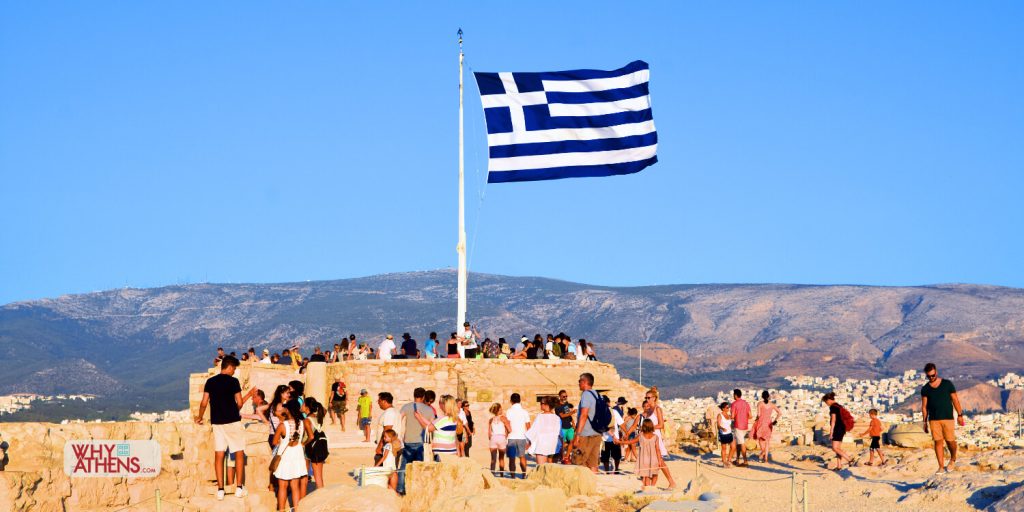
The Greek flag which is situated on what was a belvedere tower during the medieval period of the Acropolis, is more than just the best vantage point for photographs across Athens. It was here that on 30th May 1941, the 19 year old Lakis Santas and 18 year old Manolis Glezos, symbolised and inspired the resistance movement in Greece against the occupying Nazi forces of World War II. Scaling the Acropolis through an ancient passage way they had discovered from reading Greek text books, the teenagers tore down the Swastika at night, leaving the flag pole empty in what was one of the first and most famous acts of resistance against the occupying forces and made the two men into folk heroes. The pair were sentenced to death in ab-sentia as the occupying forces were unsuccessful in identifying who committed the brazen act. Apostolos ‘Lakis’ Santas went on to actively fight in the resistance movement during the second world war. He passed away in Athens in 2011 at the age of 89. Manolis Glezos retired as the oldest member of the European Parliament in 2015 at the age of 92. He passed away in March 2020 at the age of 97 on his Greek island of birth, Naxos.
_________________________
Lord Byron – A Great Philhellene
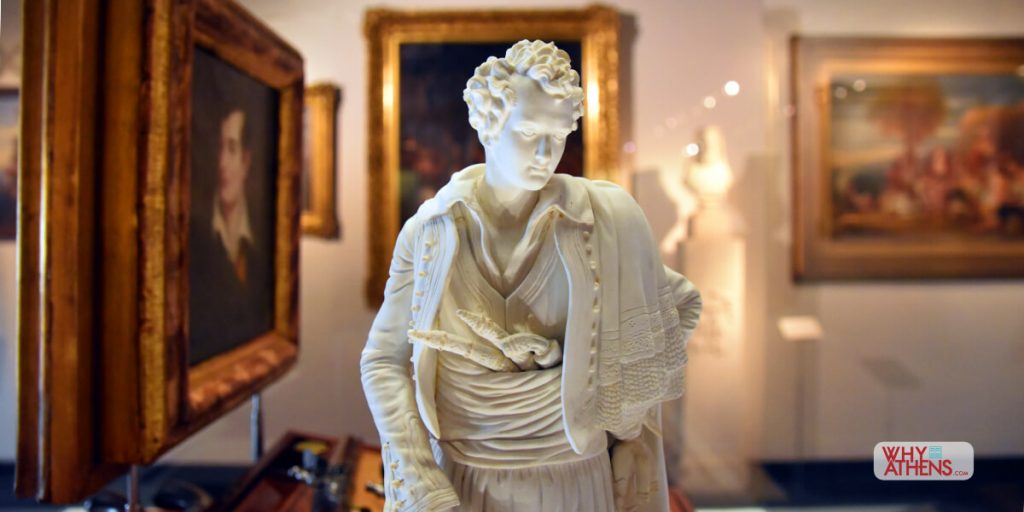
A statue of Lord Byron at the Benaki Museum in Athens. Photograph: Why Athens | Photo stories in Athens Greece
Lord Byron, the famous English poet and politician is considered a great philhellene and still celebrated in Greece today, especially for his physical and financial support of the Greeks during the war of independence in the 1820’s. A wonderful collection of Lord Byron’s personal items are part of the permanent exhibition of the Benaki Museum in Athens along with tributes to his life including this statue of Byron in a Souliot costume, traditionally worn by the resistance fighters in Epirus during the Greek War of Independence. Lord Byron died in Greece on April 19, 1824 at the age of 36 and some 8 years before the war was over.
_________________________
Ermou Street and the Church of Panaghia Kapnikarea.

The church of Panaghia Kapnikarea stands in the centre of Ermou Street. Photo Stories from Athens Greece.
Ermou Street in central Athens was one of the first roads designed in the new town plan of 1833 after Greece regained its independence. It took its name from Hermes, the ancient Greek god of commerce, to suit its role as the principal mercantile street of what was to be the new Athens. In the middle of Ermou Street is one of the oldest churches in Athens, the Panaghia Kapnikarea, built during the Byzantine period around 1050AD and is still open to the public today. The town planners of the day had resolved to either demolish or relocate the church to ensure a thoroughfare for horse and carriages. However the church had caught the eye of King Louis of Bavaria (father of the newly appointed King Otto of Greece) as an important landmark and together with Neophytos Metaxas, the Metropolitan Bishop of Athens, they ensured the street was designed with the church in place. Ermou Street is now largely pedestrianised for shopping, it stretches from the ancient cemetery of Kerameikos through to Syntagma Square, passing through Thissio, Psirri and Monastiraki on the way.
_________________________
Panathenaic Stadium – A beacon of modern Athens
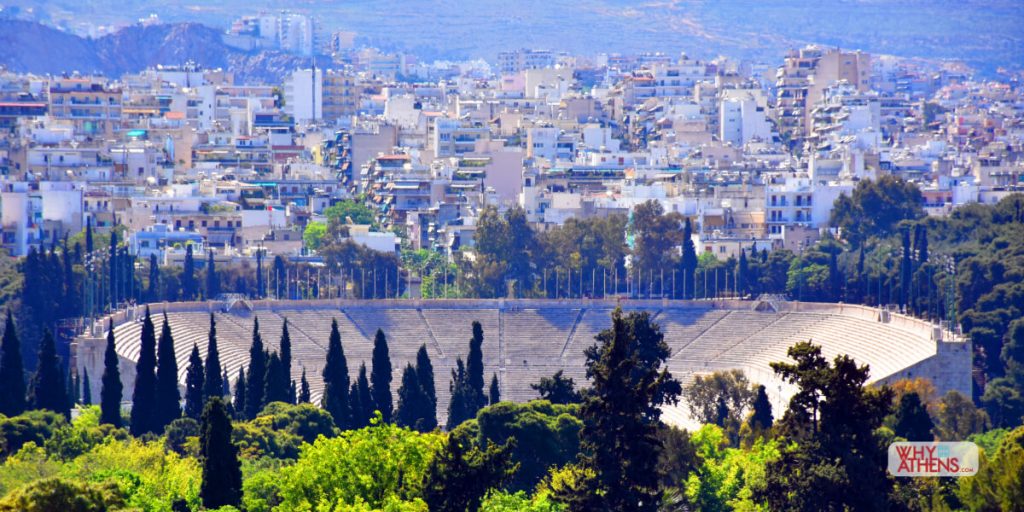
The Panathenaic Stadium, home of the first modern Olympics in 1896. Photograph: Why Athens
The Panathenaic Stadium is a symbol of Greece’s return to the western world after centuries of Ottoman occupation. When the French gathered a world congress in 1894 to discuss the concept of a modern Olympic games, it was agreed that Paris would host it in 1900 to coincide with their world fair. The Greek representative Dimitrios Vikelas saw an opportunity and suggested that Athens host the Olympics in 1896 but did so without the consent of the Greek government. The world congress agreed but the problem for Vikelas was that Greece had declared bankruptcy a year earlier and the government could not fund an Olympic games on Greek soil. Vikelas however was adamant that holding the 1st Olympic Games in Athens was an honour and something that Greece deserved. He found the support of Crown Prince Constantine and they devised a plan to privately fund the games by lobbying George Averoff, a wealthy merchant from Egypt and one of Greece’s largest ever benefactors. Averoff obliged and financed the construction of the Panathenaic Stadium insisting it be built of marble from Mt Penteli, as was used to construct the Acropolis. The 1st modern Olympics was a success, and whilst Greece of the 1890’s was still trying to evolve, Athens had taken a major step forward, bringing Greece back into Europe.
_________________________
Mikrolimano Port. Athens, Greece
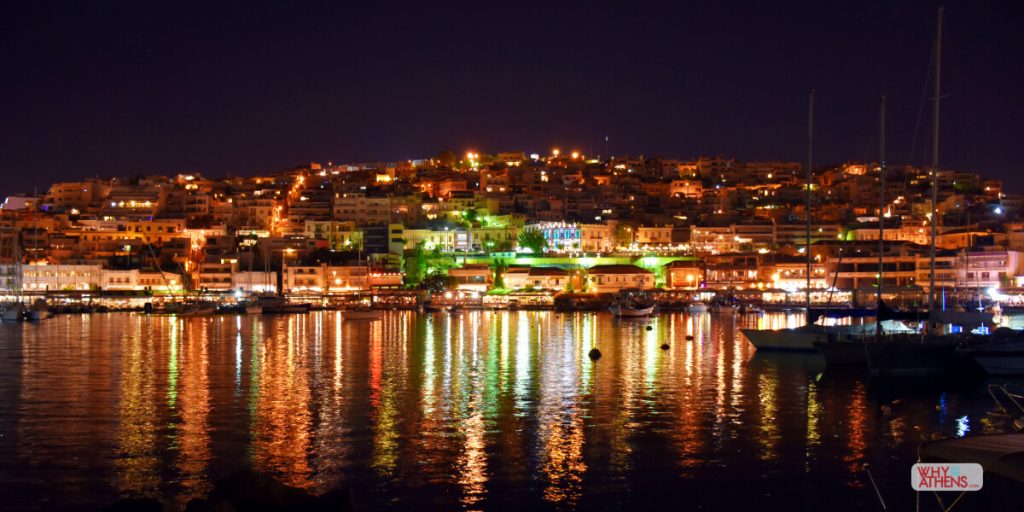
The port of Mikrolimano. Photo stories from Athens Greece.
The beautiful coastal village of Mikrolimano (literally meaning small port) is home to some of Athens’ best seafood restaurants. But Mikrolimano (and all of Piraeus) was an island separated from the mainland by a short waterway and the marshes of Halipedon until the 5th century BC. A massive building program during that period by Themistocles, Cimon and Pericles set about fortifying the area by building long walls connecting the mainland and turning Mikrolimano into the port of war for Athens. It has been known by many names throughout its long history such as Fanari (named after a lighthouse which stood during the Byzantine period), Koumoundourou (after a mansion which existed at its end), Tourkolimano (meaning Turks port during the Ottoman times) and Port Mounichia in ancient times after the goddess Mounichia Artemis. Evidence has been found of settlement around Mikrolimano back to the late Neolithic period.
_________________________
Areopagus Hill. Athens Greece
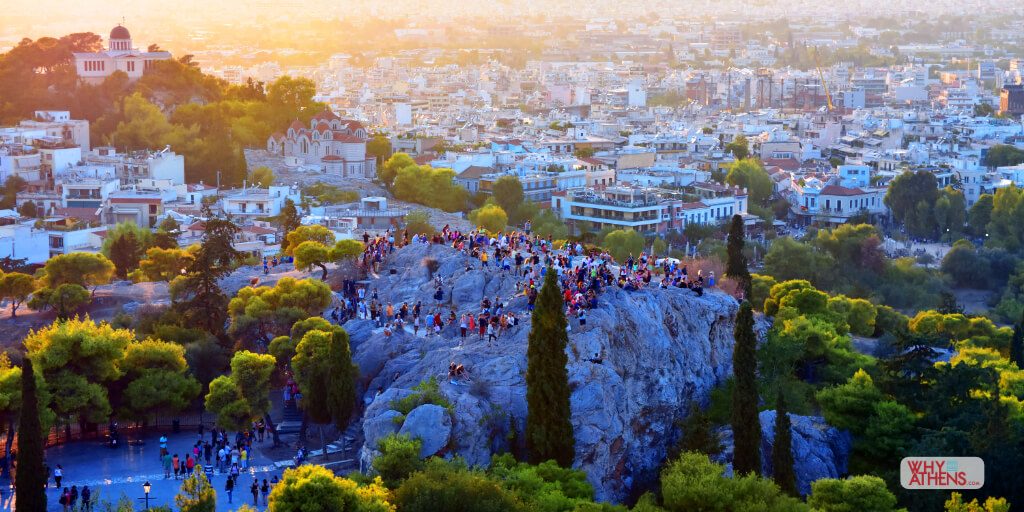
Areopagus Hill. Photo Stories from Athens Greece.
Areopagus Hill (or Mars Hill to the Romans) is often visited for its expansive views over the Ancient Agora and the Acropolis. However it’s history is fascinating. It functioned long before democracy was born as a council of elders, but in the 4th century BC, the Council of the Areopagus (nobleman of exceptional character) operated as a court of law primarily for cases related to murder and other serious crime in the new Athenian democracy. In the year 51AD, the Apostle Paul delivered his speech of the Unknown God on Areopagus Hill and converted his first Athenian nobleman, Dionysius the Areopagite, to Christianity.
_________________________
A symbol of peace, a symbol of strength. Panathenaic Stadium
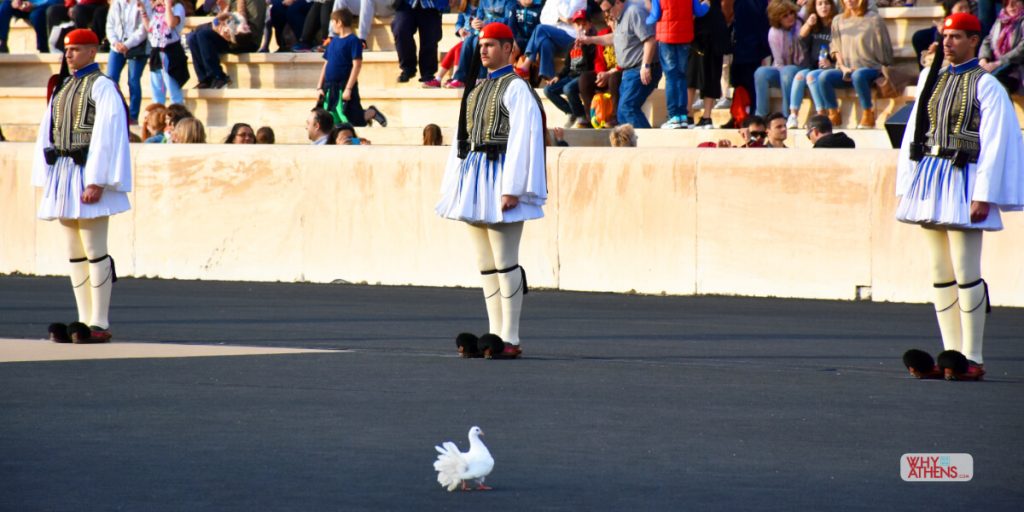
The Evzones stand guard during a ceremony at the Panathenaic Stadium. Photograph: Why Athens | Photo stories from Athens Greece.
The poise of the ‘Evzones’ or Greek Presidential Guards is something to be admired. We captured this image as a white dove flew into frame which we felt was incredibly symbolic. A strong, peaceful moment at the Panathenaic Stadium in Athens.
_________________________
The Discus Thrower. Panathenaic Stadium
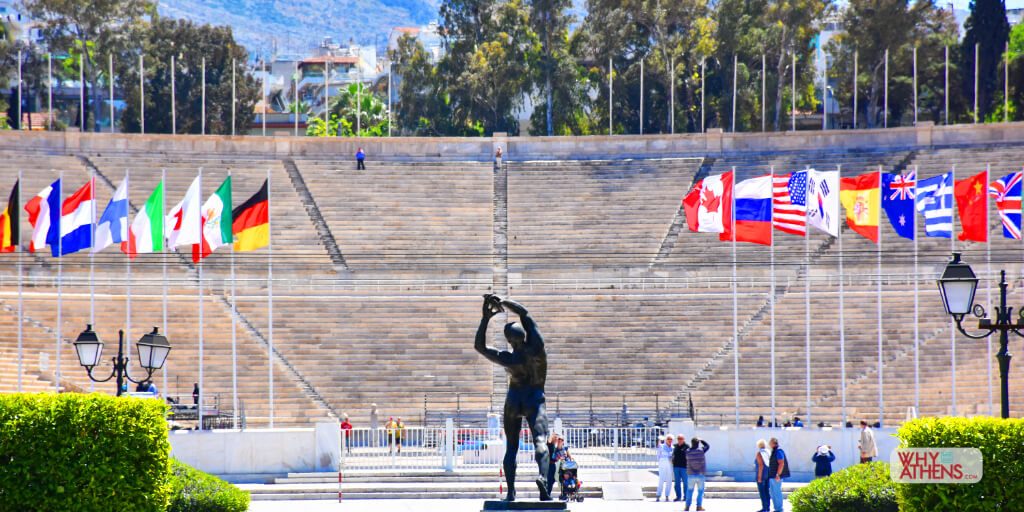
The Discus Thrower at the Panathenaic Stadium. Photograph: Why Athens | Photo stories from Athens Greece
The statue of the discus thrower is located across from the entrance to the Panathenaic Stadium, home of the first modern Olympics of 1896. The early 20th century sculptor, Konstantinos Dimitriadis won the Olympic art contest in 1924 in Paris for this work and two were made. The other was placed behind the Metropolitan Museum in Central Park, New York (it now stands at the entrance to the Municipal Stadium on Randall’s Island, New York). Dimitriadis studied at the School of Fine Arts in Athens in the late 1800’s and won a scholarship to attend the Ecole Nationale de Beaux Arts in Paris where he stayed until 1928 before returning to Athens to take charge of the Fine Arts School at the National Technical University. Dimitriadis also designed the monument of the unknown soldier, the reclining nude figure, found outside Hellenic Parliament, that was said to be controversial at the time.
_________________________
Sunset Sky. Cape Sounion

Sunset at Cape Sounio. Photo Stories from Athens Greece.
The sunsets at Cape Sounion are spectacular year round and draw crowds to the Temple of Poseidon for the best vantage point. But don’t leave too early because the short period after sunset is the best time to capture the unique colours of the Saronic Gulf. Known as the change from ‘civil dusk’ to ‘astronomical dusk’, the sun is between 6-12 degrees below the horizon and gives you the feeling of being in a heavenly paradise.
_________________________
Mosaic of Gorgon’s Head. National Archaeological Museum Athens
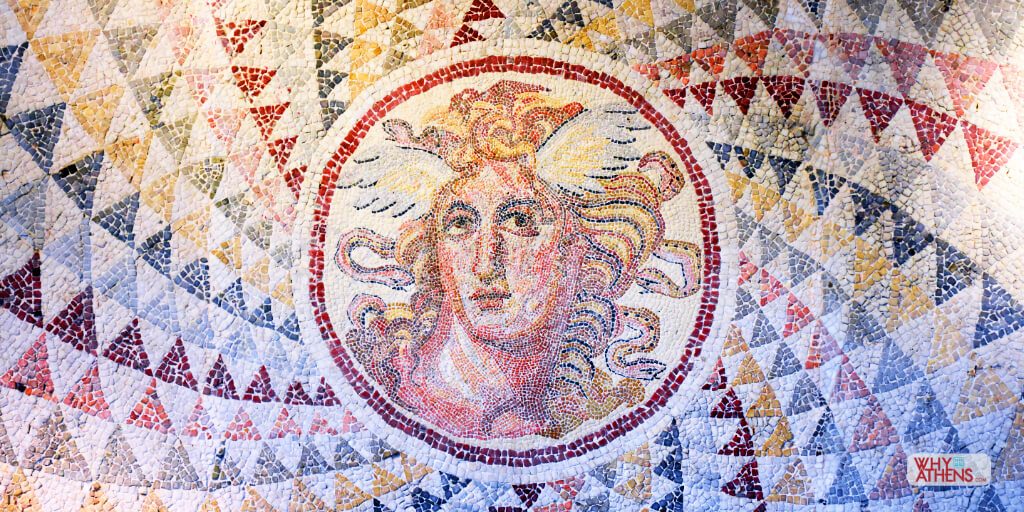
The Mosaic of Gorgon. Photo Stories from Athens Greece.
This floor mosaic was found in Zea in the coastal suburb of Piraeus in Athens. Dating back to the 2nd century AD it depicts a Gorgon’s head, which in Greek mythology is one of three sisters who had hair made of living venomous snakes, the most famous of which was Medusa. This example is on display in the garden area of the National Archaeological Museum in Athens.
_________________________
The laiki agora – The people’s market. Athens, Greece

There are hundreds of varieties of fresh fruit and vegetable on display at a laiki in Athens. Photo stories from Athens Greece
The “laiki agora” or people’s market has been an intricate part of Athenian society since ancient times. On any given day (with the exception of Sunday) you can find a laiki in operation in neighbourhoods around the capital, where designated roads are blocked off to allow people to purchase their fresh fruit, vegetables, fish and eggs straight from the farm door. Prices are yelled across the markets from stall to stall in a theatrical display of who’s got what, with the goal of selling out of their daily goods by closing time. As the seasons change in Greece, so does the produce and the laiki is a wonderful representation of what makes up the highly sought after Greek diet, famous around the world for its nutritional value.
_________________________
Hadrian’s Arch – a dedication to a great Philhellene
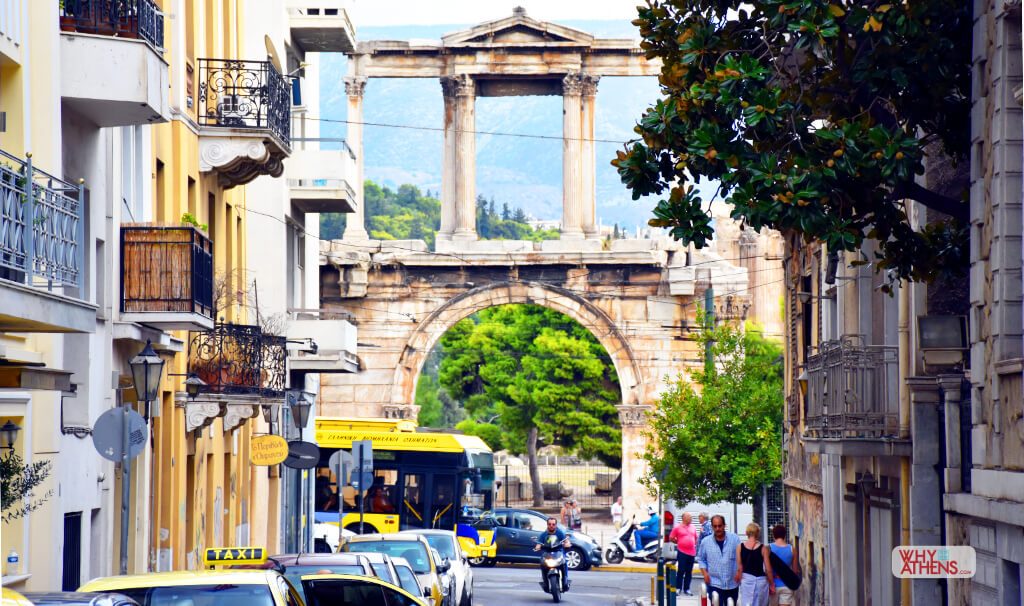
Hadrian’s Arch stands tall after almost 19 centuries | Photo stories from Athens Greece.
Whilst exploring central Athens you’ll no doubt pass this impressive structure known as Hadrian’s Arch, which was constructed in circa 131AD in honour of the Roman Emperor, Hadrian. It stands at the entrance of the Temple of Olympian Zeus, just 300 metres from the Acropolis in Athens. 2017 marked 1,900 years since the start of Hadrian’s rule over the empire in 117AD which included Greece and Asia Minor, a position he held for 21 years and was the third of the five ‘good emperors’.
Hadrian is remembered as a great Philhellene, an admirer of ancient Greek civilisation and he demonstrated this by seeking to make Athens the cultural centre of Europe. Hadrian sought and won the approval of the provincial areas of Greece through the construction and restoration of many public sites and aqueducts before putting his stamp on Athens, a city he lived in three times during his reign as Emperor. His achievements in Athens were numerous and influential as he caused a building renaissance including the completion of the Temple of Olympian Zeus which still stands today and the establishment of the Panhellinion – the council of Greek city-states aimed at reunifying ancient Greece.
_________________________
The Salepi vendor in Winter. Monastiraki, Athens Greece

A Salepi vendor in Monastiraki | Photo stories from Athens Greece
As the winter season takes hold in Athens, warm the soul with a cup of Salepi found here at this street stand in Monastiraki. Made from wild orchid flowers, a flour dust is stirred with water or mixed with hot milk. Salepi was a common beverage throughout the Ottoman Empire but was also widely consumed in England in the 17th & 18th centuries as an alternative to coffee. Puddings and ice-creams are often made with Salep flour and found particularly in Turkey. This street vendor warms his Salepi with hot coals found underneath the large brass samovars.
_________________________
Pittaki Street. Psirri, Athens Greece

Pittaki Street in Psirri | Photo stories from Athens Greece.
The lighting installation on Pittaki Street in Psirri has become one of Athens’ most photographed streets. Established in late 2012, the project aimed to rejuvenate an otherwise abandoned alleyway which fell victim to the economic climate. The brainchild of the community organisation ‘Imagine the City’ and the design firm Beforelight Group, the people of Athens were invited to donate their old lampshades and light fittings as a contribution to the project. Overwhelmed with hundreds of donations, the team chose 150 different lighting fixtures in what was to be a 6 month experiment. Four years on, the ‘Synoikia Pittaki’ is a cultural and community landmark and a symbol of an Athens in transformation.
_________________________
The view from Castella
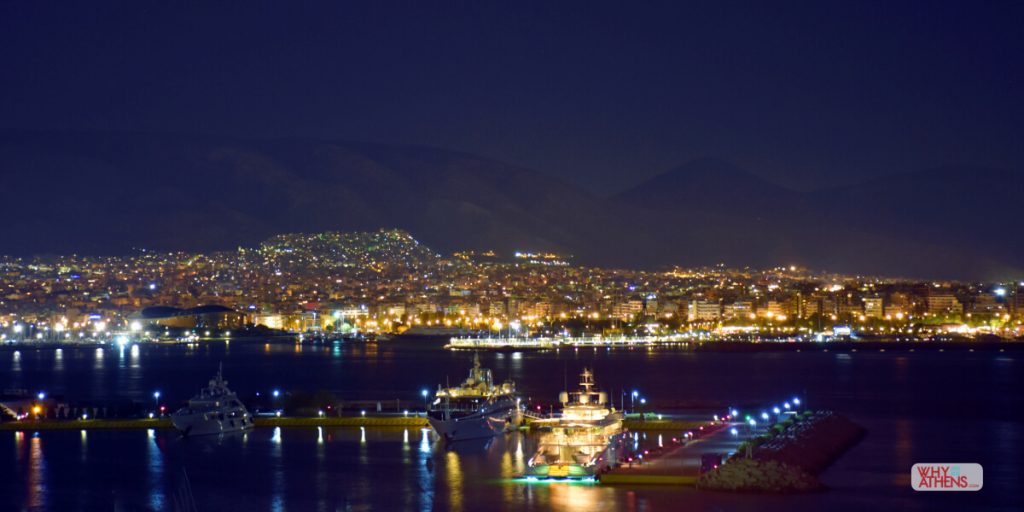
The view from Castella out to the Athenian Riviera | Photo stories from Athens Greece.
Castella is a hilltop neighbourhood northwest of Mikrolimano near Piraeus. With expansive views down the Athenian Riviera from Palaio Faliro to Vouliagmeni, it is especially beautiful at night. The area is distinct for its architecture dating from the 19th century as one of the first developed when Greece regained its independence, but the significance of the highest point of the hill dates back to the 5th century BC when it was considered one of the most important lookout points for the three harbours of war built by Themistocles, Cimon and Pericles as part of their plan to defend Athens.
_________________________
Old Lady of the Revolution. Hilton Hotel Athens Greece
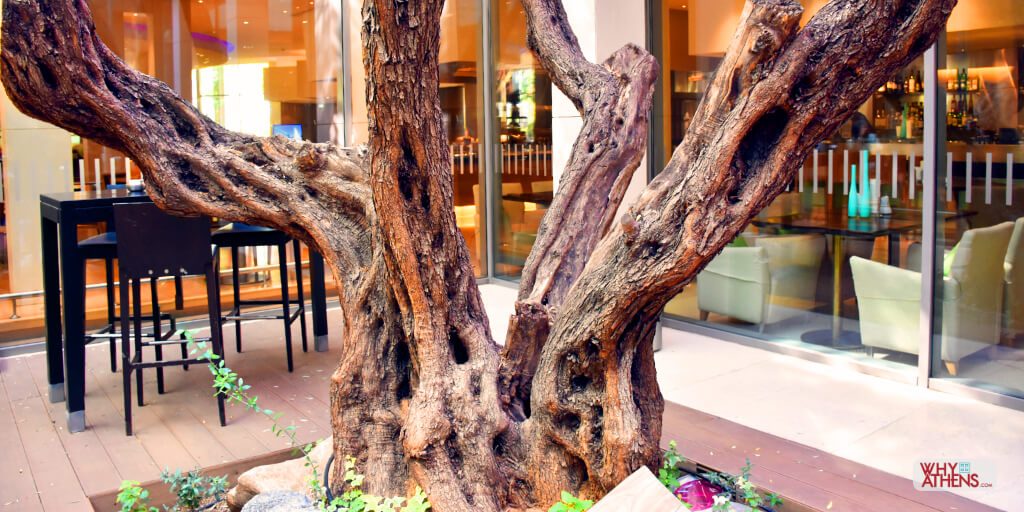
The ‘Old Lady’ of the Hilton | Photo stories from Athens Greece
Known as the ‘Old Lady’, this Athenian olive tree has survived for over 200 years and originally lived in Rizokastro, a neighbourhood in Plaka. Proving her resilience, the tree lived through the Greek War of Independence where a Turkish cannonball was fired and became embedded in her trunk. In 1962 the Old Lady, along with her 2 tonnes of roots were transplanted from Plaka to the Hilton Hotel in Athens where today she is the centrepiece of the hotel’s ground floor restaurant. The cannonball which sat in her trunk for many years sits in the ground next to her as a reminder of her legacy and story that should not be forgotten.
_________________________
Lake Vouliagmeni. Athens Greece

Lake Vouliagmeni. Photo stories from Athens Greece.
As the Autumn seas start to cool, Athens is blessed with places to swim with warmer waters. Lake Vouliagmeni on the Athenian riviera is a natural phenomenon set beneath a limestone cavern. The deep caves feeding the lake source water from both the sea and earth making for 25 degree celsius water temperatures year round and a mineral rich experience that the locals swear by for its therapeutic qualities.
_________________________
Greek National Library
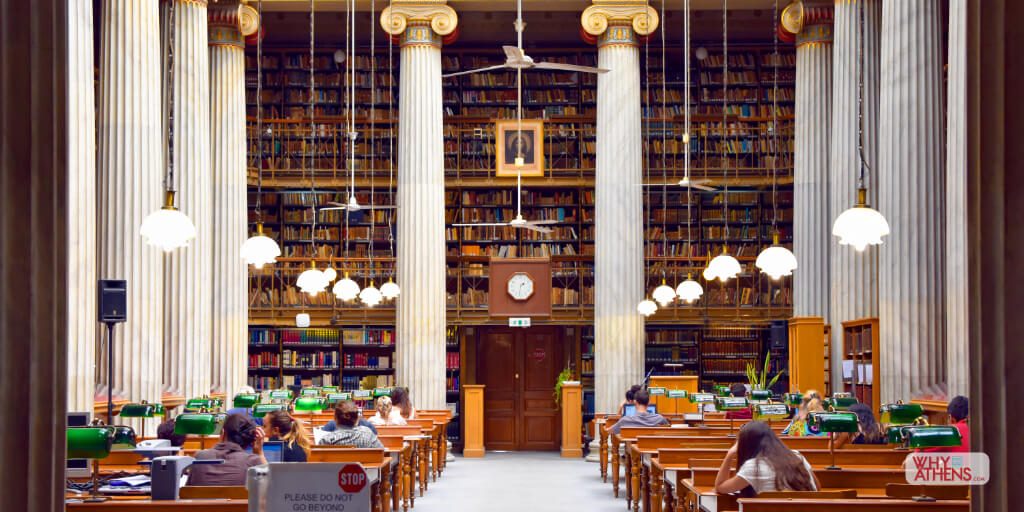
The reading room of the Greek National Library. Photo stories from Athens Greece.
The National Library of Greece is one of the three beautiful neoclassical buildings on Academias Street in central Athens. Its foundation dates back to the 1830’s during the turbulent period of Greece’s independence and found its permanent home here in 1903. The main reading room has an ornate glass ceiling providing ideal lighting conditions for the century of people who have studied the collection of over 2 million volumes of books and manuscripts dating back 1,500 years. The extended home for the National Library will open at the Stavros Niarchos Foundation Cultural Centre in 2017.
_________________________
Stoa Emporon – The Merchants Arcade

The artistic lighting installation at the Stoa Emporon in Syntagma. Photo stories from Athens Greece
The arcades or ‘stoa’ are synonymous with Athens’ architecture and a part of the city’s mercantile history. Small businesses once flourished through these passageways but many have closed down during the economic crisis. The Stoa Emporon is one example of an abandoned thoroughfare that has now become an open museum thanks to an art and light installation commissioned by the City of Athens. Discarded signs were collected from all over Athens, repaired and restored as a tribute to the merchants of the past and breathing new life into an almost forgotten space.
_________________________
Plato at the Academy of Athens
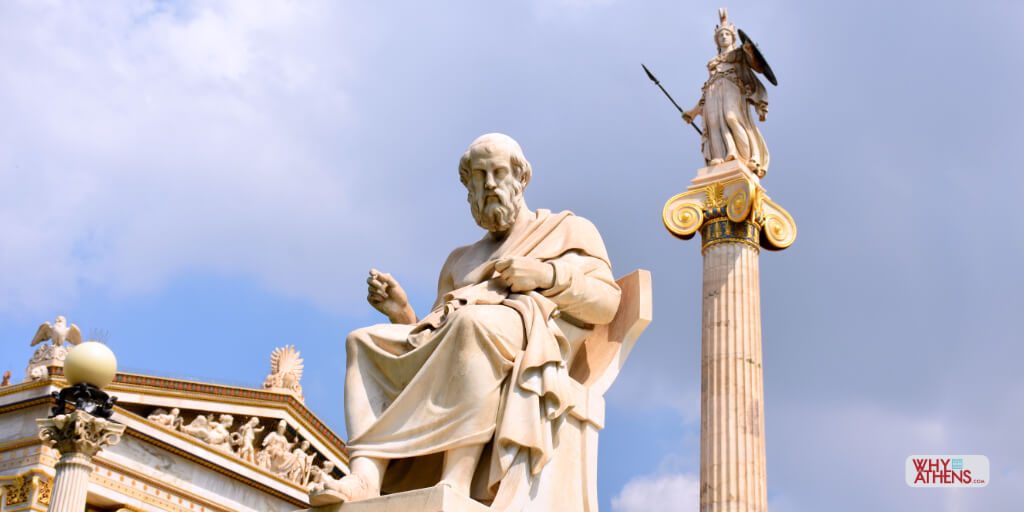
The statue of Plato with Athena at the Academy of Athens. Photo stories from Athens Greece
The seated marble figure of Plato is watched over by the goddess Athena at the Academy of Athens, Greece’s highest research institution. The impressive works are part of a series by the Greek neo-classical sculptor Leonid Drosis in front of the Academy which also include the god Apollo, the philosopher Socrates and the impressive pediment sculpture themed on the birth of Athena which won first prize at the Vienna Exhibition of 1873. The Academy building was completed in 1887 and is the finest example of neo-classical architecture in Athens, with its design inspired by the Erechtheion at the Acropolis.
_________________________
Shadow on the fallen. Hellenic Parliament
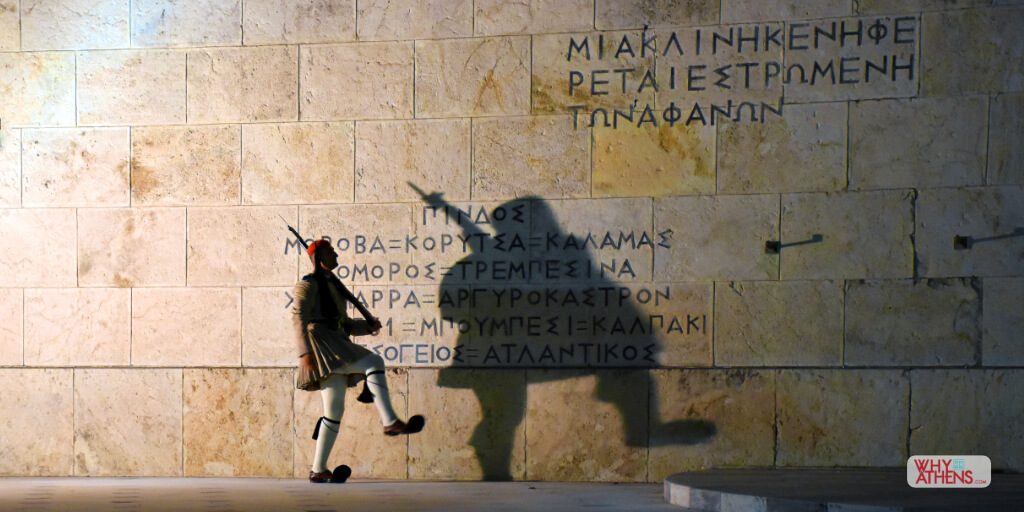
An Evzone guarding the Tomb of the Unknown Soldier. Photo Stories from Athens Greece.
In front of Hellenic Parliament lies the Tomb of the Unknown Soldier, protected by the Greek Presidential Guard known as the Evzones. On either side of the tomb are two quotes taken from Pericles’ Funeral Ovation which he delivered after the first year of the Peloponnesian war in 430BC as referenced by Thucydides’ history of the war. Visible here in the top right of the photo it says, Μία κλίνη κενὴ φέρεται ἐστρωμένη τῶν ἀφανῶν ‘one bed is carried empty, made for the unknown ones’. On the opposite side of the tomb it says, Ἀνδρῶν ἐπιφανῶν πᾶσα γῆ τάφος, ‘The whole earth is the burial ground of famous men’. The Evzone’s shadow is cast over the names of the cities where the Greek army fought during the Balkan, Greco-Turkish, Russian and World Wars. It was customary in Athens from the 5th century BC to hold a public funeral each year to honour those who died at war.
_________________________
Strefi Hill. Athens Greece
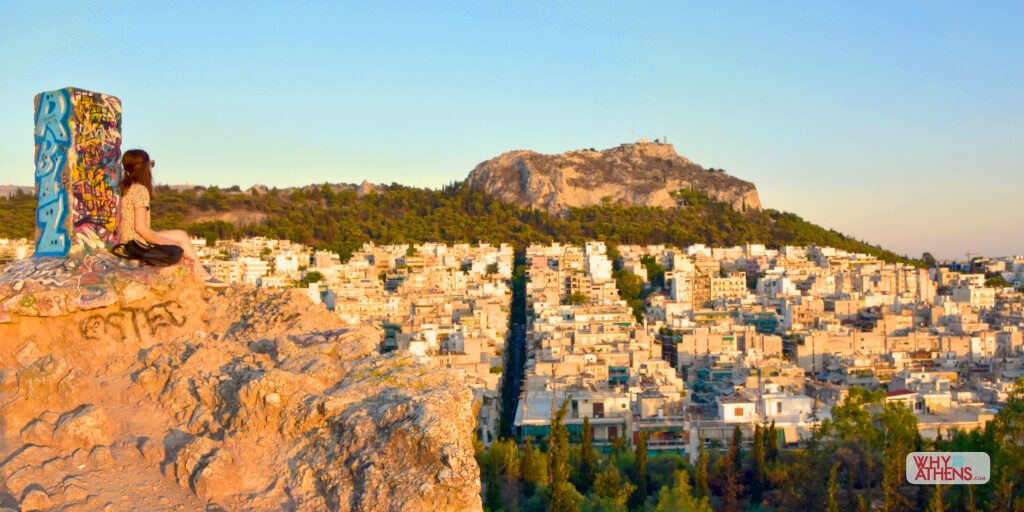
The view from Strefi Hill. Photo Stories from Athens Greece.
Strefi Hill is located in the inner city suburb of Exarchia and has commanding views over Athens and one of the best places to capture both Lycabettus Hill and the Acropolis. The land was owned by the Strefis family who operated a quarry on the site from the mid 1800’s through to 1920 and its rock was used in the surrounding areas to construct buildings still standing today. After the closure of the quarry, trees were planted to control the dust from affecting the newly built surrounding suburbs and in 1963 the Strefis family gifted the entire site to the City of Athens. The hill has an elevation of over 150 metres and occupies 48 acres of land.
_________________________
The Greek Tortoise. Temple of Olympian Zeus
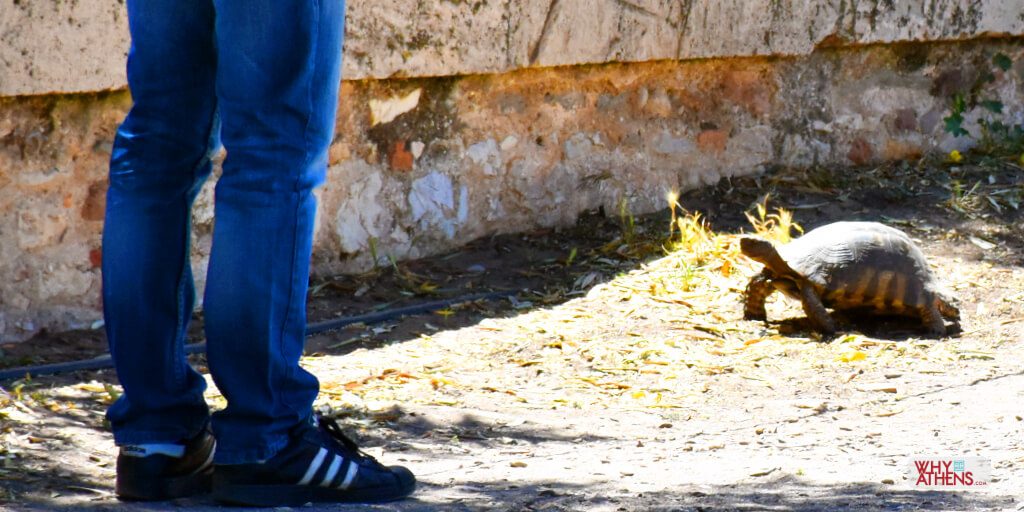
The Greek Tortoise of Athens. Photo Stories from Athens Greece.
Athens is full of gentle, friendly creatures. The Greek tortoise (a.k.a spur-thighed tortoise ‘Testudo Graeca’) is often a pleasant surprise for visitors. In any given day you will find a tortoise in many of the ancient sites such as the Temple of Olympian Zeus, where we found our little friend pictured here. Many of these sites were built around or on top of small rivers and water sources, which today still exist although not immediately visible and it’s where our little friends play and exist. Who knows how old they are, but they are very cute and love the attention.
_________________________
Young Hermes. Ancient Agora
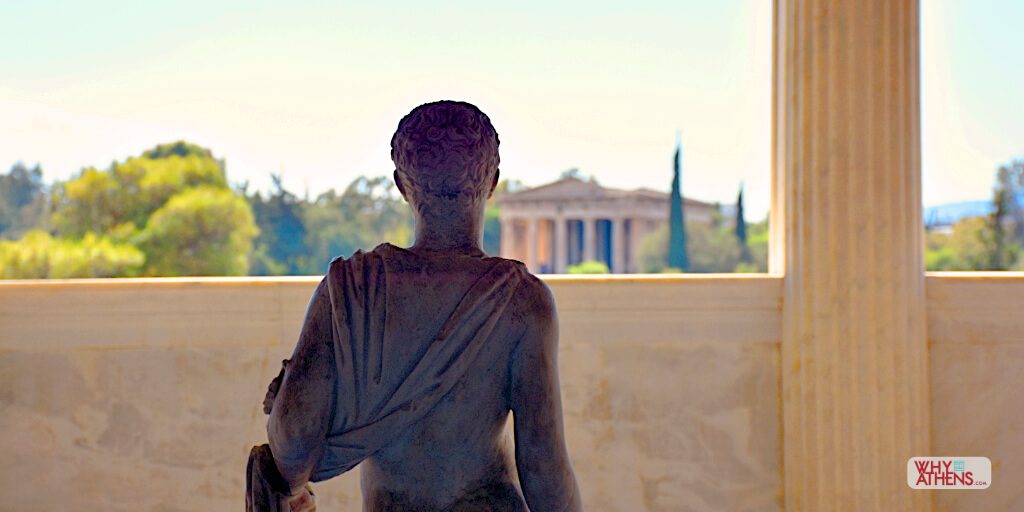
Young Hermes. Photo Stories from Athens Greece.
If the marbles could speak what would the young Hermes (pictured here) think of modern Athens today as he looks out over the Ancient Agora to the Temple of Hephaestus? The artefacts displayed on the second floor of the Stoa of Attalos represent works that would have adorned the Ancient Agora during the Hellenistic period (from 3rd century BC) where idealistic images of gods and mortals were portrayed. They are some of the most famous and well known images we associate with Ancient Greece today.
_________________________
City of Athens Marching Band. Panathenaic Stadium
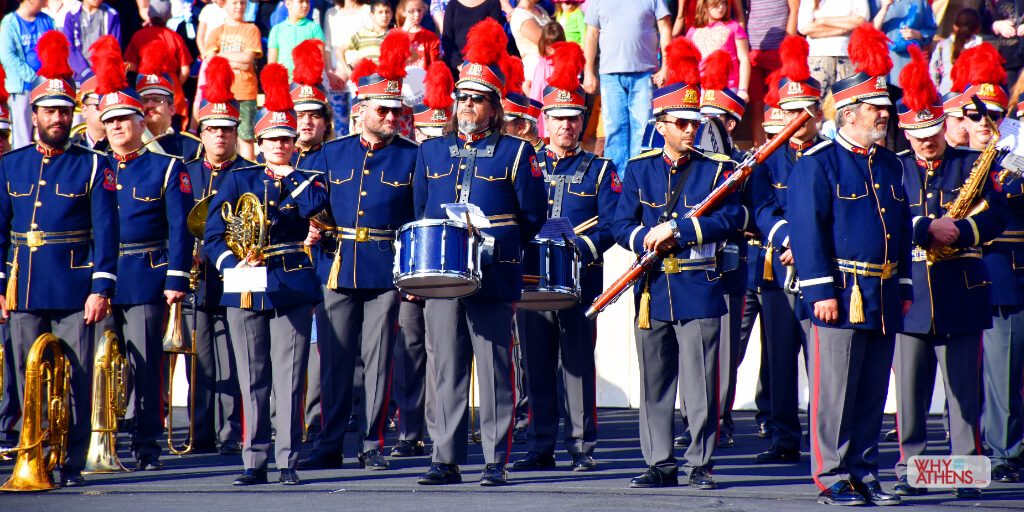
City of Athens Marching Band. Photo Stories from Athens Greece.
The City of Athens Marching Band is recognisable not only for their distinctive red sash hats but we also think they have an element of rock star about them. Athens is a city with many significant events throughout the year and the band is often called to action to lead a parade.
_________________________
Fresco at St Dionysios Church. Kolonaki Athens

Fresco at St Dionysios Church. Photo Stories from Athens Greece.
Athens is full of beautiful churches with some dating back to the 11th century AD. Whether you are religious or not, the architecture and frescos that adorn the walls from the Byzantine period are wonderful to see.
_________________________

